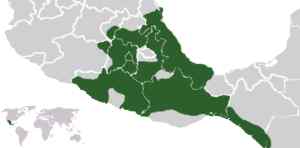Definition

The Aztec Empire flourished between c. 1345 and 1521 CE and, at its greatest extent, covered most of northern Mesoamerica. Aztec warriors were able to dominate their neighbouring states and permit rulers such as Motecuhzoma II to impose Aztec ideals and religion across Mexico. Highly accomplished in agriculture and trade, the last of the great Mesoamerican civilizations was also noted for its art and architecture which ranks amongst the finest ever produced on the continent.
The Aztec state is actually the most well documented Mesoamerican civilization with sources including archaeology, native books (codices) and lengthy and detailed accounts from their Spanish conquerors - both by military men and Christian clergy. These latter sources may not always be reliable but the picture we have of the Aztecs, their institutions, religious practices, warfare and daily life is a rich one and it continues to be constantly expanded with details being added through the endeavours of 21st century CE archaeologists and scholars.
The empire was kept together through the appointment of officials from the Aztec heartland, inter-marriages, gift-giving, invitations to important ceremonies, the building of monuments and artworks which promoted Aztec imperial ideology, and most importantly of all, the ever-present threat of military intervention. Some states were integrated more than others whilst those on the extremities of the empire became useful buffer zones against more hostile neighbours, notably the Tarascan civilization.
The Aztec state is actually the most well documented Mesoamerican civilization with sources including archaeology, native books (codices) and lengthy and detailed accounts from their Spanish conquerors - both by military men and Christian clergy. These latter sources may not always be reliable but the picture we have of the Aztecs, their institutions, religious practices, warfare and daily life is a rich one and it continues to be constantly expanded with details being added through the endeavours of 21st century CE archaeologists and scholars.
Historical Overview
Sometime around 1100 CE the city-states or altepetl which were spread over central Mexico began to compete with each other for local resources and regional dominance. Each state had its own ruler or tlatoani who led a council of nobles but these small urban centres surrounded by farmland soon sought to expand their wealth and influence so that by c. 1400 CE several small empires had formed in the Valley of Mexico. Dominant amongst these were Texcoco, capital of the Acholhua region, and Azcapotzalco, capital of the Tepenec. These two empires came face to face in 1428 CE with the Tepanec War. The Azcapotzalco forces were defeated by an alliance of Texcoco, Tenochtitlan (the capital of the Mexica) and several other smaller cities. Following victory a Triple Alliance was formed between Texcoco, Tenochtitlán and a rebel Tepanec city, Tlacopan. A campaign of territorial expansion began where the spoils of war - usually in the form of tributes from the conquered - were shared between these three great cities. Over time Tenochtitlán came to dominate the Alliance, its ruler became the supreme ruer - the huey tlatoque ('high king') - and the city established itself as the capital of the Aztec empire.
Masters of the world, their empire so wide and abundant that they had conquered all the nations. Diego Durán
The empire continued to expand from 1430 CE and the Aztec military - bolstered by conscription of all adult males, men supplied from allied and conquered states, and such elite groups as the Eagle and Jaguar warriors - swept aside their rivals. Aztec warriors wore padded cotton armour, carried a wooden or reed shield covered in hide, and wielded weapons such as a super sharp obsidian sword-club (macuahuitl), a spear or dart thrower (atlatl), and bow and arrows. Elite warriors also wore spectacular feathered and animal skin costumes and headdresses to signify their rank. Battles were concentrated in or around major cities and when these fell the victors claimed the whole surrounding territory. Regular tributes were extracted and captives were taken back to Tenochtitlán for ritual sacrifice. In this way the Aztec empire came to cover most of northern Mexico, an area of some 135,000 square kilometres.The empire was kept together through the appointment of officials from the Aztec heartland, inter-marriages, gift-giving, invitations to important ceremonies, the building of monuments and artworks which promoted Aztec imperial ideology, and most importantly of all, the ever-present threat of military intervention. Some states were integrated more than others whilst those on the extremities of the empire became useful buffer zones against more hostile neighbours, notably the Tarascan civilization.








